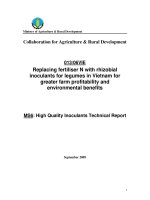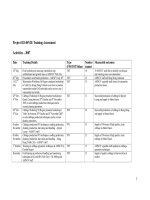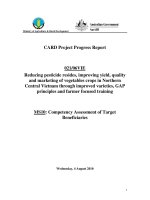Báo cáo khoa học nông nghiệp " Genetic materials and silvicultural techniques in plantation-grown acacias for sawn timber products " pot
Bạn đang xem bản rút gọn của tài liệu. Xem và tải ngay bản đầy đủ của tài liệu tại đây (4.33 MB, 24 trang )
Genetic materials and silvicultural techniques in
plantation-grown acacias for sawn timber products
Collaboration in Agriculture and Rural
Development
Project VIE:032/05
“Sustainable and profitable
development of acacia plantations for
sawlog production in Vietnam”
In this presentation
Introduction
Objectives
Study materials and methods
Genetic materials for sawlogs
Thinning response to diameter growth
Pruning response to log defects
Preliminary results from the silvicultural trials
Conclusions
Introduction
• Acacia species introduced in the 1960s
– Adapted to lowland environments
– Important tree species
• 400,000 ha of Acacia plantation
– Pulp and small sawlogs
– High demand
• Vietnam’s demand for industrial wood is
predicted to be 9.35M m
3
by 2010
– 300,000 m
3
from natural forest
– The balance from forest plantations in
Vietnam or imports
Why grow sawlogs?
• Sawlogs fetch a higher price than pulp logs
–1 m
3
of acacia wood equals about one green tonne
– Minimum sawlog length is 2 m, minimum small end diameter 15 -18 cm
depending on sawmill type
• Pulpwood price (2008) at forest roadside is currently about 600,000 dong per
green tonne (bark removed) and 900,000 dong delivered to chipmill gate
• Sawlog prices in rural areas of north and central Vietnam, July 2008 are
approximately as follows:
Log small end diameter Price paid at sawmill
(Dong per cubic metre
)
< 15 cm 700,000
15-20 cm 1.2 M
20-30 cm 1.5 M
>30 cm 2 M
Study objectives
• To examine the currently available genetic material for acacia sawlog
plantations in Vietnam and recommend the best propagation methods for
each species
• To demonstrate and verify the recommended package of germplasm and
silvicultural techniques for sustainable acacia sawlog production through a
scientifically designed and monitored establishment trial, and thinning and
pruning trials in already-established plantations, in Central Vietnam.
Study materials
• Genetic review:
Published references (both in Vietnam and tropical countries) and experiences from experts
• Thinning trial
– A 2.5 year-old Acacia hybrid (BV10, BV16 & BV 32) plantation located at Dong Hoi -Quang
Binh
– Initial spacing: 4 m x 2.5 m.
–MAI 20 m
3
ha
-1
yr
-1
over the rotation
• Sustainable silvicultural trial
– An acacia hybrid plantation at Dong Ha – Quang Tri (MAI: 19-20 m
3
ha
-1
yr
-1
)
– Mixed clones of acacia hybrid (BV10, BV16, BV 32, BV71, BV73 and BV75)
Study methods
• Genetic review (Inheritable and expert methods)
• Thinning trial
– Four thinning treatments (1000, 600, 450 and 300 trees/ha).
– Randomised Complete Block Design (4 replicates)
– All trees within the treatments were pruned up to 2,3m from the ground.
– Remove the branches as close as possible to the branch collar and without damaging the
branch collar
• Sustainable silvicultural trial
– Harvested previous plantation and retained slash and litters
– Randomised complete block design: 5 treatments & 4 replicates
o no fertilizer + Pre-planting herbicide spray and two sprays/year
o 10 g elemental P + Pre-planting herbicide spray and two sprays/year
o 20 g elemental P + Pre-planting herbicide spray and two sprays/year
o 20 g elemental P + 10 g K + Pre-planting herbicide spray and two sprays/year
o no fertilizer + two hand weeding /year
• Data collections and Statistical analysis
o D
g
, Dbh and Ht of all trees in each trial were collected.
o In the thinning trial, tree volume was calculated by the formula: V=((π Dbh
2
)/4)*Ht*f,
o All data analyses were done by GENSTAT 8.0.
Right √√√
Side branches pruned close
to stem using secateurs,
shears or pruning saw
Wrong
×××
Side branches pruned
using machete, leaving
dead branch stubs that
will cause wood defects
18 months after
pruning, wound
has healed over
Genetic materials for sawlogs
Species and provenances suited
to sawlog plantation
Species:
A. auriculiformis
A. mangium
A. crassicarpa
A. mearnsii
A. melanoxylon
Provenances
• A. auriculiformis: Coen River (Qld), Morehead River
(Qld) and Mibini (PNG).
• A. mangium: Iron Range (Qld) and Pongaki (PNG)
• A. crassicarpa: Mata province (PNG), Deri-Deri (PNG)
and Dimisisi (PNG).
Suitable eco-regions
Low land areas:
9 A. auriculiformis: Centre and South
9 A. mangium: North
9 A. crassicarpa: centre and south
9 Acacia hybrid: North, Centre and South
High land areas:
A. mearnsii (Bodalla and Nowa Nowa)
and A. melanoxylon (Mount Mee )
Superior clones
• A. auriculiformis (18 clones):
9 AA15, AA9, AA1, BVlt25, BVlt83, BVlt84,
BVlt85, Clt7, Clt57, Clt64, Clt98, Clt133,
Clt1F, Clt18, Clt19, Clt171, Clt26, Clt43
9 MAI: 15-33.6 m
3
/ha/year
9 Clone: Clt7, Clt12 , Clt18 , Clt25 (low
shrinkage)
• Acacia hybrid (16 clones):
9 BV10, BV16, BV32, BV33, BV71, BV73,
BV75, M8, MA1, AM3, AM2, AH1, AH7, TB1,
TB7, TB11
9 MAI: 15-40 m
3
/ha/year
Recommended propagation method
Species or hybrid Recommended propagation method
A. auriculiformis Mass clonal propagation of best tested clones
“Orchard elite” seed from SPAs or seed orchards
where clonal propagation not available
A. crassicarpa “Orchard elite” seed from SPAs or seed orchards
A. mangium “Orchard elite” seed from FSIV’s SPAs and SSOs
Acacia hybrid
(A. mangium x
A. auriculiformis)
Mass clonal propagation of best tested clones
approved by MARD. Seed from hybrid trees must
never be collected and used
A. mearnsii and A. melanoxylon “Elite tree” seed from provenace trials or seed
orchards
Thinning response to diameter growth
• Sig. difference
• Trees in thinning treatments: Dbh ≥ 16 cm
• Trees in control treatment: Dbh = 14.5 cm
• Acacia plantations established at stockings of
1100-1667 stems/ha.
• Thinning down to 600 trees/ha at age 2.5-3
years could provide an initial harvest of
pulpwood and enable the retained trees to
produce a crop of small sawlogs on rotations
as short as 5-6 years.
Pruning response to log defects
Tree No. Treatment
Dbh
(cm)
Defects per board
Tree
No.
Treatment
Dbh
(cm)
Defects per board
Outer
wood
Knotty
core wood
Outer
wood
Knotty
core wood
1 pruned 21.0 0.6 4.8 1 unpruned 19.3 1.0 6.8
2 pruned 18.3 0.8 4.8 2 unpruned 21.8 0.0 2.8
3 pruned 19.0 0.0 3.8 3 unpruned 25.0 1.5 4.0
4 pruned 19.1 0.3 5.3 4 unpruned 20.8 0.4 5.8
5 pruned 20.5 0.0 4.6 5 unpruned 21.4 1.4 5.5
6 pruned 18.6 1.0 5.0 6 unpruned 19.9 2.2 5.2
7 pruned 17.6 0.3 3.3 7 unpruned 21.1 1.6 4.4
8 pruned 20.6 0.6 6.6 9 unpruned 21.5 1.6 5.4
9 pruned 21.1 1.6 5.4 10 unpruned 22.0 1.6 6.2
11 pruned 19.3 0.0 5.6 11 unpruned 22.4 0.4 4.3
12 pruned 19.1 0.6 3.6 12 unpruned 21.9 1.2 6.4
13 pruned 18.8 0.4 3.8 13 unpruned 21.7 1.2 5.0
14 pruned 20.5 0.3 6.8 14 unpruned 19.2 1.6 4.8
15 pruned 19.4 0.0 5.8 15 unpruned 20.8 1.6 4.0
Mean, pruned trees 19.5 0.5 4.9 Mean, unpruned
trees
21.3 1.2 5.0
Significance of treatment effect P<0.001 not
significant
Significance of treatment effect P<0.001 not
significant
No relationship between individual log Dbh and N
o
of outer-wood defects per board
Number of outerwood defects per board
0
1
1
2
2
3
16 20 24
log dbh (cm)
No. of defects/board
pruned
unpruned
• Lift pruning at age 2.5
years (dbh=9.5 cm)
enabled the production
of largely defect-free
clearwood in the outer
wood
• First-lift pruning should
be carried out slightly
earlier, while the lowest
branches are still alive
Boards from pruned tree No. 5
Boards from unpruned tree No. 3
Preliminary results from
the silvicultural trials
Treatment Nutrition treatment Vegetation
management
Mean tree
height at 10
months (m)
Mean tree
height at 16
months (m)
T1 Control – no fertilizer herbicide 1.98 3.88
T2 P
1
10 g elemental P applied as
superphosphate
herbicide 2.83 4.17
T3 P
2
20 g elemental P applied as
superphosphate
herbicide 2.82 4.57
T4 P
3
(=P
2
+ 10 g elemental K plus
additional 20 g P per tree
applied 1 year after planting)
herbicide 2.85 4.55
T5 Control – no fertilizer manual weeding
twice per year
2.15 3.83
• Acacias are nitrogen-fixing, a process that often responds strongly to additions of P fertiliser
• Overall survival of 85% for all treatments at age 16 months after planting
• A clear response in early growth to phosphorus fertilizer application (P<0.001)
• Need to answer an important question: whether the early growth response translates into
improved plantation productivity over the full rotation, and improves soils for successive
plantation harvests???
No fertilizer 20 grams elemental P per tree
Retaining slash and litter can improve tree growth
Conclusions
• A. auriculiformis (centre &south), A. mangium (north) and A.
crassicarpa (centre & south) are suitable for sawlog plantation in
lowland areas.
• A.mearnsis and A. melanoxylon are suitable for highland areas
• The thinning and pruning were the most important in sawlog
plantations to produce defect-free clearwood
• Addition of 20 g of phosphorus fertilizer at time of planting is
sufficient to give a marked response in early height growth in
Quang Tri and could sustained a full rotation of acacia hybrid
growth
Singling is
recommended
very important
in acacia
plantation
Form pruning is
also recommended
very important in
acacia plantation
Tools for acacia stand management
Machete - OK for singling but do not use for pruning
(cannot cut close to main stem, or will damage bark)
Pruning saw – suitable for singling and pruning, branches > 1 cm
Hand shears –effective for pruning branches up to 1.5 cm
Long-handled pruning shears – very effective for branches up
to 3 cm, can prune up to 2 m above ground without ladder.
*Available from Husquevarna shop in Melinh Plaza, Hanoi
Acknowledgment
Ministry of Agriculture and Rural Development
Dr. Ha Huy Thinh and staff in RCFTI
Mr. Vu Dinh Huong
Mr. Dang Thinh Trieu
Mr. Trieu Thai Hung
Dr. Nambiar
Dr. Chris Harwood
Dr. Chris Beadle
Mr. Khongsak Pinyopusarerk









